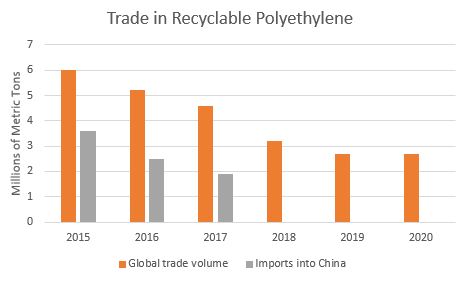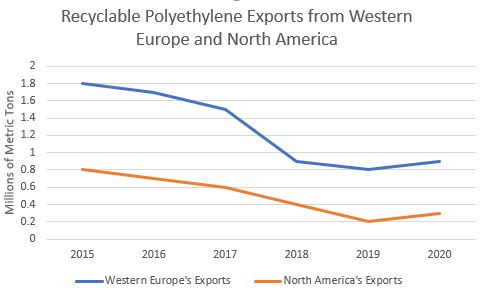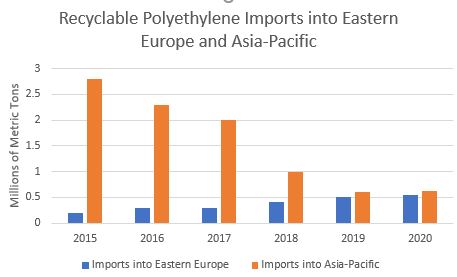The volume of recyclable polyethylene traded globally has fallen by more 50% from 2015, resulting in profound changes in regional trade flows.
RPE – recyclable polyethylene – is waste, parings and scrap that is identifiable as polyethylene and is traded under a specific harmonized System code number. It can range from relatively clean factory cuttings to post-consumer HDPE milk bottles.
In 2015, there were 6.0 million tons of RPE traded globally. By the end of 2020, a trade volume of 2.7 million tons is projected, which which appears to have stabilized at the same volume as in 2019. Volume fell from 2015 through 2019, with the sharpest drop in 2018, after China prohibited all imports.

The loss of China as a major destination sharply reduced exports from Western Europe and North America.

Western Europe’s exports fell from 1.8 million tons in 2015 to 0.9 million tons projected for 2020. In addition, the destination for Western Europe’s exports shifted. In 2015, of the 1.8 million tons exported, 1.6 million tons went to Asia-Pacific and 190,000 tons to Eastern Europe. By year end 2020, nearly 500,000 tons will go to Eastern Europe and only 356,000 tons to Asia-Pacific.
North America’s exports dropped from 840,000 tons in 2015 to 275,000 tons in 2020. Asia-Pacific, however, continues to be the top destination for North America’s exports, with relatively small volumes to Latin America and Eastern Europe.
Imports into Asia-Pacific have fallen from 2.8 million tons in 2015 to 630,000 tons in 2020, while imports into Eastern Europe over the period (mainly Turkey), rose from 240,000 tons to 550,000 tons.

From International Trader Publications’ Recyclable Polyethylene World Trade Report, a continuously updated analysis of RPE global trade, based on statistics from key countries.
